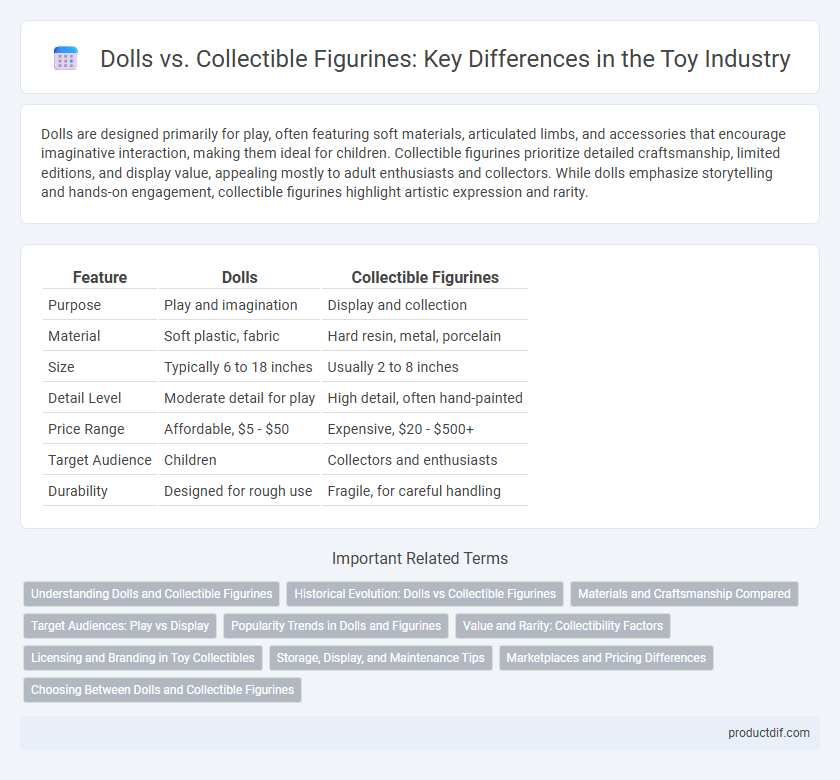Dolls are designed primarily for play, often featuring soft materials, articulated limbs, and accessories that encourage imaginative interaction, making them ideal for children. Collectible figurines prioritize detailed craftsmanship, limited editions, and display value, appealing mostly to adult enthusiasts and collectors. While dolls emphasize storytelling and hands-on engagement, collectible figurines highlight artistic expression and rarity.
Table of Comparison
| Feature | Dolls | Collectible Figurines |
|---|---|---|
| Purpose | Play and imagination | Display and collection |
| Material | Soft plastic, fabric | Hard resin, metal, porcelain |
| Size | Typically 6 to 18 inches | Usually 2 to 8 inches |
| Detail Level | Moderate detail for play | High detail, often hand-painted |
| Price Range | Affordable, $5 - $50 | Expensive, $20 - $500+ |
| Target Audience | Children | Collectors and enthusiasts |
| Durability | Designed for rough use | Fragile, for careful handling |
Understanding Dolls and Collectible Figurines
Dolls are typically designed for play and come in various sizes and materials such as plastic, cloth, or vinyl, often featuring movable joints and lifelike features to engage children. Collectible figurines are primarily created for display purposes, crafted with intricate details using resin, porcelain, or metal to appeal to collectors and enthusiasts. Understanding the distinction helps consumers choose products based on intended use, whether interactive play or aesthetic collection.
Historical Evolution: Dolls vs Collectible Figurines
Dolls have evolved from ancient handcrafted objects used in rituals and children's play to intricately designed toys reflecting cultural heritage, while collectible figurines originated primarily as decorative items inspired by art, mythology, or pop culture icons. The 19th century marked a significant shift as mass production enabled dolls to become more accessible and diverse, whereas collectible figurines gained popularity through limited editions and collaborations with renowned artists and franchises. Modern advancements in materials and technology further distinguished dolls, often made from vinyl or cloth for play, from highly detailed collectible figurines crafted with resin or porcelain for display.
Materials and Craftsmanship Compared
Dolls are commonly made from soft materials like cloth, vinyl, or silicone, emphasizing flexibility and lifelike textures, while collectible figurines are often crafted from rigid substances such as resin, porcelain, or metal to highlight intricate details and durability. The craftsmanship of dolls centers on realistic facial features, articulated joints, and clothing design, whereas collectible figurines prioritize fine sculpting, hand-painted finishes, and precise character representation. Material choice directly influences the level of detail, with collectible figurines showcasing higher precision due to harder media compared to the more tactile and poseable nature of dolls.
Target Audiences: Play vs Display
Dolls primarily target children and young audiences seeking interactive play experiences that foster imagination and social development. Collectible figurines appeal to adult collectors and enthusiasts who value detailed craftsmanship and limited editions for display purposes. The distinction between these toys lies in their intended use: dolls encourage hands-on engagement, while collectible figurines serve as decorative items and investment pieces.
Popularity Trends in Dolls and Figurines
Dolls maintain strong popularity among children and collectors due to their role in imaginative play and nostalgia, with brands like Barbie and American Girl leading sales worldwide. Collectible figurines, including Funko Pop! and limited-edition anime models, have surged in demand, especially among adult collectors seeking exclusive and rare items. Market analysis indicates that while dolls appeal broadly across age groups, collectible figurines experience rapid growth fueled by pop culture trends and online communities.
Value and Rarity: Collectibility Factors
Dolls typically have sentimental value and appeal due to their size, articulation, and playability, often mass-produced but occasionally released as limited editions that increase their worth. Collectible figurines, especially those made from durable materials like resin or porcelain, gain value through rarity, brand collaborations, and detailed craftsmanship that attract adult collectors. Both categories' market prices are influenced by the item's condition, production quantity, and demand within niche collector communities.
Licensing and Branding in Toy Collectibles
Licensing plays a critical role in the value and appeal of both dolls and collectible figurines, often determining authenticity and market demand. Dolls typically feature licensed characters from popular media franchises, enhancing emotional connection and brand loyalty among collectors. Collectible figurines rely heavily on licensing agreements to showcase iconic designs and limited editions, driving exclusivity and higher resale value within the toy collectibles market.
Storage, Display, and Maintenance Tips
Dolls require careful storage in breathable, acid-free materials to prevent fabric deterioration, while collectible figurines benefit from dust-free display cases with UV protection to maintain paint integrity. Maintaining dolls involves gentle cleaning with mild detergents and avoiding direct sunlight to preserve colors, whereas figurines demand regular dusting with soft brushes and occasional touch-ups for paint chips. Organizing storage by type and size prevents damage and ensures easy access for both dolls and collectible figurines, enhancing longevity and visual appeal.
Marketplaces and Pricing Differences
Dolls often dominate traditional toy marketplaces with pricing influenced by mass production and brand popularity, whereas collectible figurines are primarily sold through specialty stores and online platforms targeting niche collectors, commanding higher prices due to limited editions and craftsmanship. Market data indicates that collectible figurines can fetch prices up to five times greater than standard dolls, driven by exclusivity and detailed artistry. Consumer demand in online marketplaces like eBay and Etsy shows consistent growth for rare figurines, contrasting with more stable pricing trends for dolls in retail chains.
Choosing Between Dolls and Collectible Figurines
Choosing between dolls and collectible figurines depends on their intended purpose and personal preference. Dolls often offer interactive features, customizable clothing, and appeal to children or those seeking playability, while collectible figurines emphasize detailed craftsmanship, limited editions, and display value for adult collectors. Understanding the differences in materials, scale, and market demand can guide buyers to make informed decisions based on their interests in play versus collection.
Dolls vs collectible figurines Infographic

 productdif.com
productdif.com